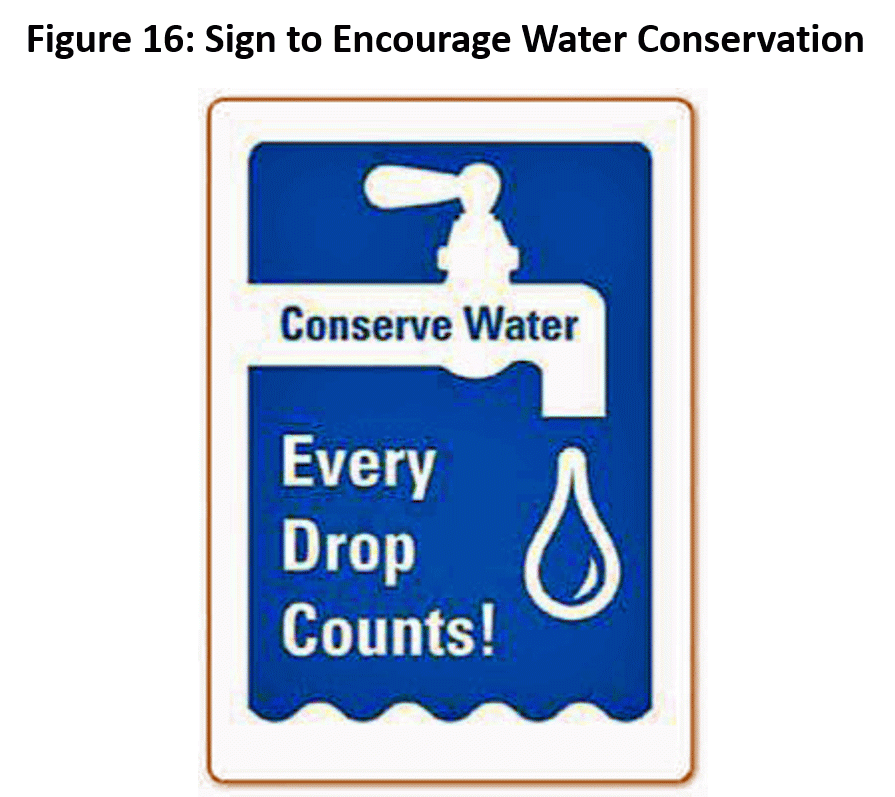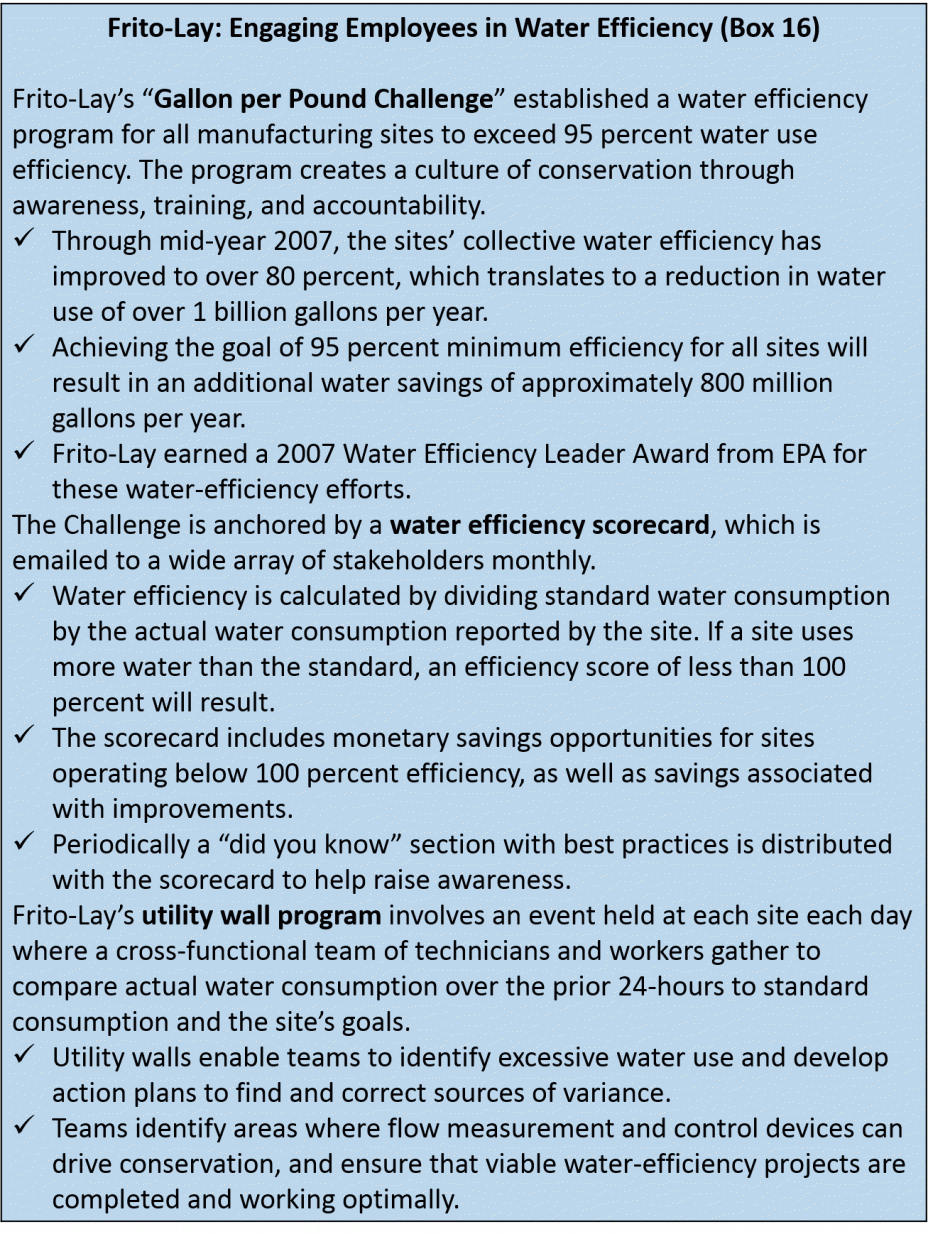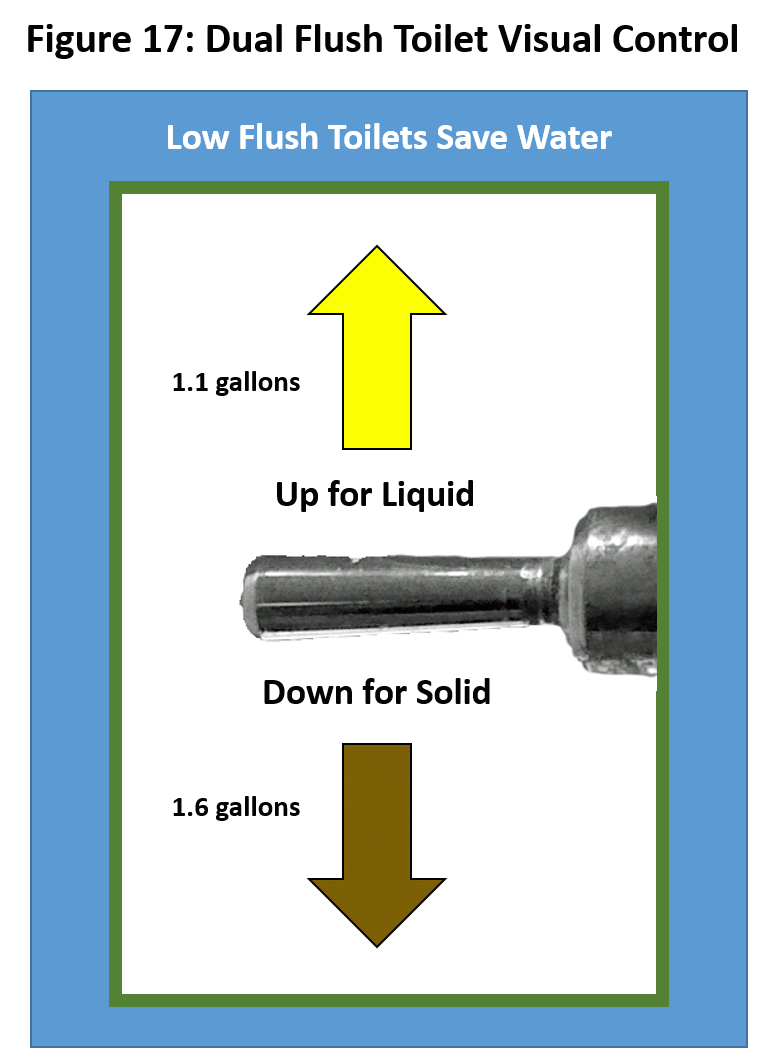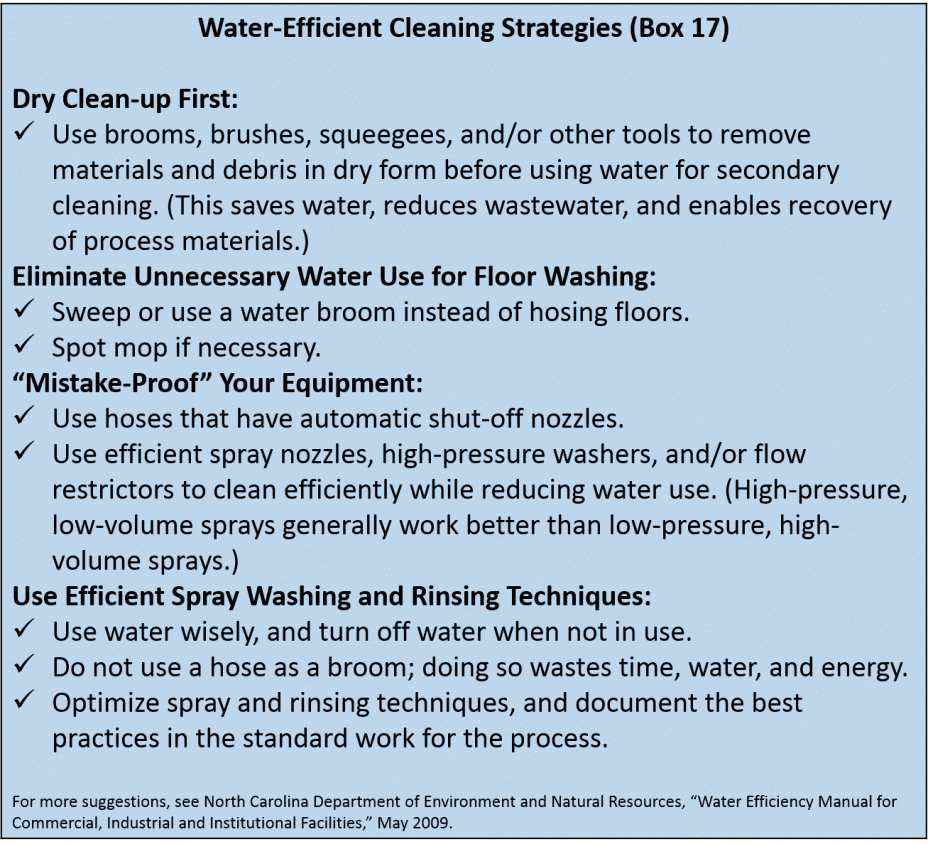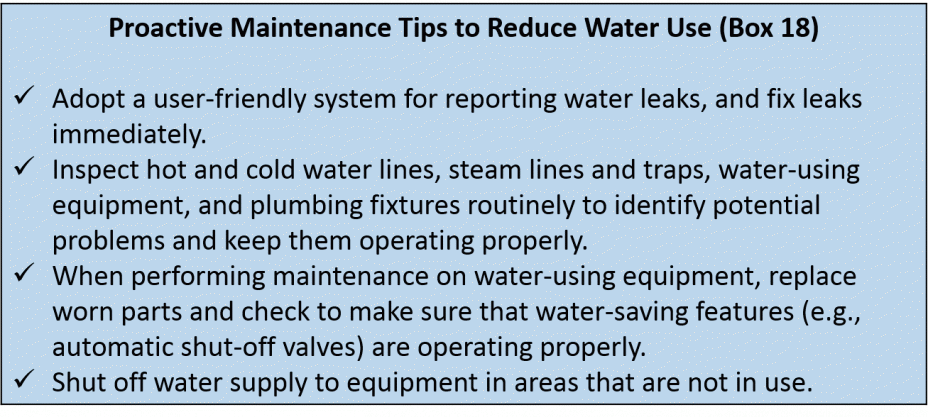Lean & Water Toolkit: Chapter 4
Lean and Water Efficiency Improvement Strategies
- Kaizen Events and Just-Do-Its to Reduce Water Use
- Integrate Water Efficiency into Everyday Lean Practices
- Lean and Water Applications for Facility Operations and Support Processes
- To Consider
- Toolkit Navigation
Kaizen Events and Just-Do-Its to Reduce Water Use
There are three key questions to ask to identify water-efficiency opportunities:
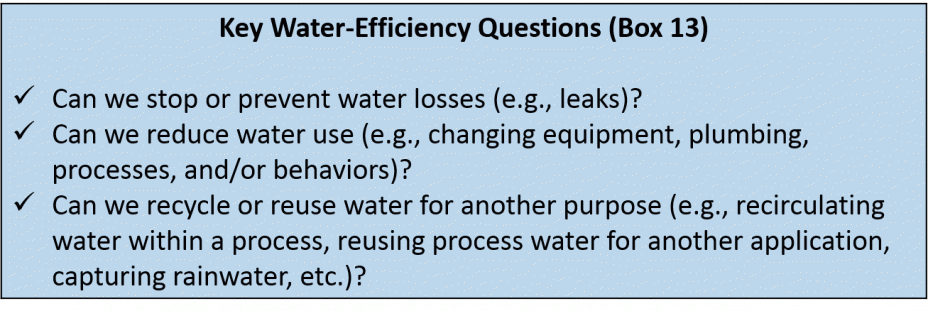
![]() Lean’s implementation-based methods of kaizen events and just-do-its are powerful strategies for putting water efficiency into practice—just-do-its for easy changes and kaizen events for more involved projects. A kaizen event—also known as a rapid process improvement event—is a 2–5 day period when a cross-functional team examines a process and makes rapid changes to improve it.
Lean’s implementation-based methods of kaizen events and just-do-its are powerful strategies for putting water efficiency into practice—just-do-its for easy changes and kaizen events for more involved projects. A kaizen event—also known as a rapid process improvement event—is a 2–5 day period when a cross-functional team examines a process and makes rapid changes to improve it.
![]() Before initiating significant process changes, remember to consult with your local utility or environmental agency to make sure that all facility permitting requirements are met. EHS staff at your facility can provide guidance on which changes may trigger regulatory or worker health and safety issues.
Before initiating significant process changes, remember to consult with your local utility or environmental agency to make sure that all facility permitting requirements are met. EHS staff at your facility can provide guidance on which changes may trigger regulatory or worker health and safety issues.
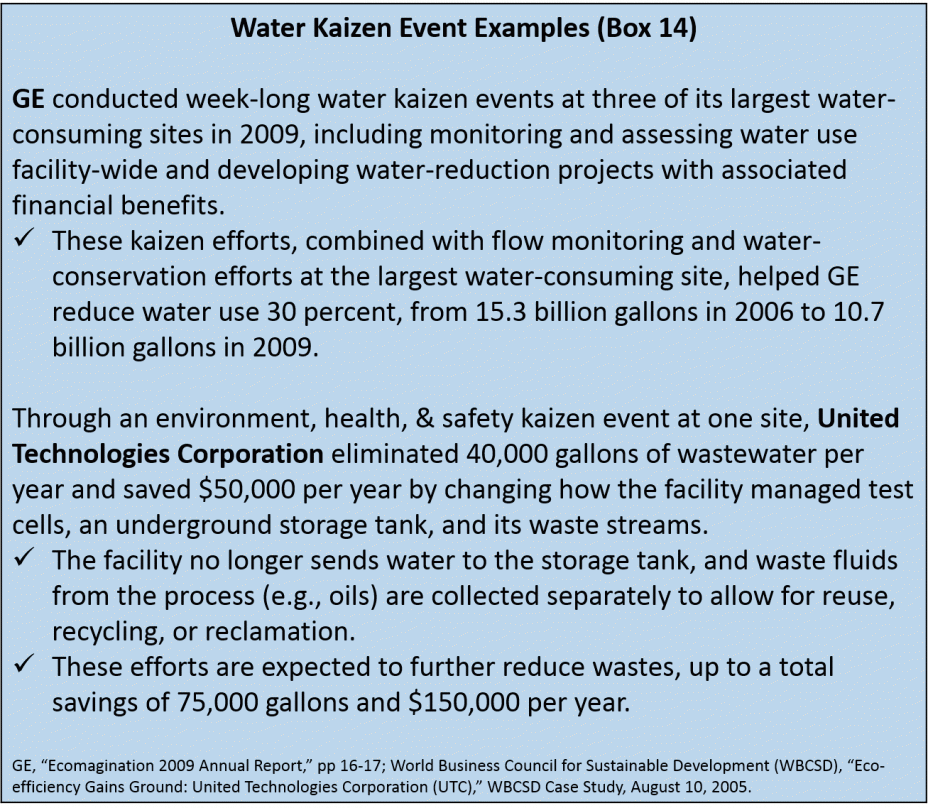 Two types of kaizen events to reduce water use include:
Two types of kaizen events to reduce water use include:
 Water Kaizen Events: Consider conducting some kaizen events that are specifically designed to find and implement water efficiency opportunities (see Box 14 for examples). Good places to target include processes or areas of facility operations that use significant amounts of water. Some companies, such as GE, use kaizen events to look for water-efficiency opportunities across a single facility. Water balances and value stream maps with water data can provide good ideas for where to focus water kaizen implementation activities.
Water Kaizen Events: Consider conducting some kaizen events that are specifically designed to find and implement water efficiency opportunities (see Box 14 for examples). Good places to target include processes or areas of facility operations that use significant amounts of water. Some companies, such as GE, use kaizen events to look for water-efficiency opportunities across a single facility. Water balances and value stream maps with water data can provide good ideas for where to focus water kaizen implementation activities.- Kaizen Events on Water-Using Processes: Even if the main objective of a kaizen event is not water efficiency, it’s helpful to keep an eye out for water-efficiency opportunities. There may be opportunities to reduce water use, such as by adjusting equipment or reusing water, while also improving other aspects of the process. Use the Key Water-Efficiency Questions in Box 13 above to identify water-savings opportunities.
Often when you’re looking for water waste, perhaps while using strategies described in the last chapter, you’ll find easy solutions that can be ![]() implemented right away. These are good things to address with “just-do-it” Lean activities. Just-do-its, or “quick wins,” are actions that individuals can take immediately to improve a process or operation. Many actions to stop water losses (such as fixing leaks or shutting off water that shouldn’t be running) or simple equipment adjustments to conserve water (such as reducing water flow) fall in this category.
implemented right away. These are good things to address with “just-do-it” Lean activities. Just-do-its, or “quick wins,” are actions that individuals can take immediately to improve a process or operation. Many actions to stop water losses (such as fixing leaks or shutting off water that shouldn’t be running) or simple equipment adjustments to conserve water (such as reducing water flow) fall in this category.
Water Efficiency Strategies
Ways to reduce water use range from simple strategies, such as adjusting the flow of water or installing water-saving devices on equipment, to more involved options such as reusing water or changing to a low-water or waterless process. There are five general types of water-saving strategies (see Figure 15). Consider these strategies as you brainstorm improvement ideas in kaizen events and other Lean efforts. Key things to keep in mind include:
- Consider water efficiency improvements in the context of other process improvements and Lean performance goals, in order to get the best results.
- Evaluate how the process changes might affect wastewater volume or quality, or have other environmental impacts. (For example, switching from a water-based lubricant to an oil-based lubricant or solvent could have implications for worker health and/or the environment.)
- Consider which water-efficiency best management practices and technologies make sense for your facility.
- Adopt visual controls, “mistake proof” devices on equipment (e.g., automatic shut offs), and/or procedures to help ensure that process changes are effective and can be easily maintained.
- After testing potential solutions, making changes, and evaluating actual performance, be sure to develop or update the standard work for the activity so that workers can easily identify the current, best way to perform an activity. (Standard work is also further discussed below.)
![]() When evaluating water reuse opportunities, it’s important to consider both water quality and water quantity. Not all processes need the cleanest, highest-quality water. In many cases you may be able to reuse the “waste” water from one process or operation as an input to another process or for another use at your facility (e.g., air handling condensate, reverse osmosis reject water, etc.), as long as you match the quality of water needed for its intended use. You may need to do some testing and additional treatment of the process water to
When evaluating water reuse opportunities, it’s important to consider both water quality and water quantity. Not all processes need the cleanest, highest-quality water. In many cases you may be able to reuse the “waste” water from one process or operation as an input to another process or for another use at your facility (e.g., air handling condensate, reverse osmosis reject water, etc.), as long as you match the quality of water needed for its intended use. You may need to do some testing and additional treatment of the process water to ![]() make sure it is acceptable for the next use. When evaluating the feasibility of using process water for irrigation or other outdoor uses, check with your local utility or water pollution control agency about restrictions on water reuse applications. The water may require testing to ensure it meets pollutant limits.
make sure it is acceptable for the next use. When evaluating the feasibility of using process water for irrigation or other outdoor uses, check with your local utility or water pollution control agency about restrictions on water reuse applications. The water may require testing to ensure it meets pollutant limits.

![]() You can use the Table for Evaluating Water Reuse Potential below as a simple guide to identify possible ways to reuse water to meet the water quality and quantity needs of processes. You may also want to consider using reclaimed municipal water or water from another facility for certain uses.
You can use the Table for Evaluating Water Reuse Potential below as a simple guide to identify possible ways to reuse water to meet the water quality and quantity needs of processes. You may also want to consider using reclaimed municipal water or water from another facility for certain uses.
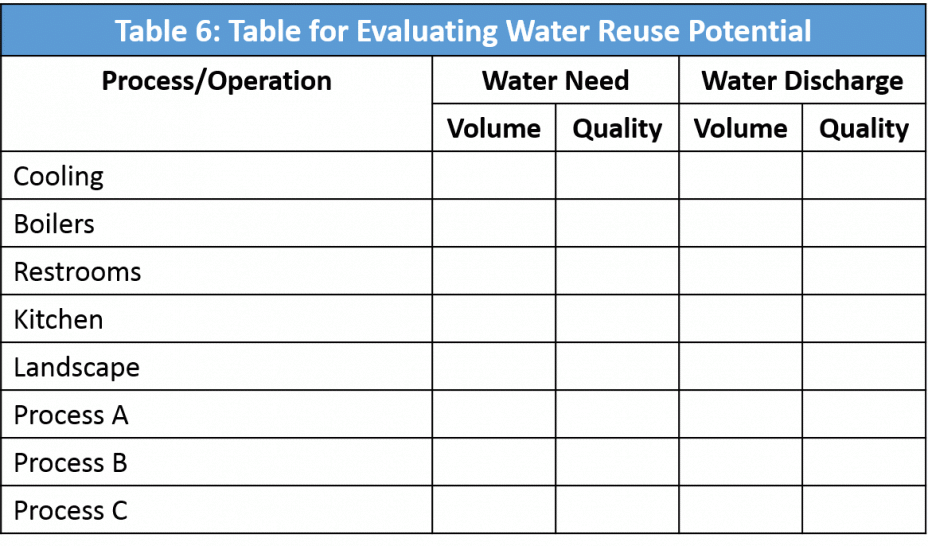 It may be possible for your facility’s water to be reused by another industry or business. Look for these potentially symbiotic relationships with other facilities in order to stretch the value of your water even further for the community.
It may be possible for your facility’s water to be reused by another industry or business. Look for these potentially symbiotic relationships with other facilities in order to stretch the value of your water even further for the community.
Integrate Water Efficiency into Everyday Lean Practices
A variety of Lean tools—including standard work, visual controls, 5S, and total productive maintenance (TPM)—help workers identify and eliminate waste in their daily activities, as described further below. Along with other wastes, these Lean tools can reinforce and promote strategies to reduce unnecessary water use.
Waste Elimination Culture
You can integrate water efficiency into the “culture of Lean” at your facility, developing the capacity of your employees to identify water waste in their normal work practices and find solutions that help meet your facility’s Lean and water goals. When your workers are passionate about improving the way your facility uses water, the gains you achieve can become self-sustaining into the future.
Lean is built around the framework of eliminating waste and striving for perfection, or “True North,” as discussed in Chapter 1. It is most successful when employees are fully engaged in driving out waste and identifying improvement opportunities. In the long run, developing people to be effective problem solvers is more important than implementing specific tools. It is critical, therefore, to train employees on how to identify water waste and to encourage and motivate them to work towards your organization’s water efficiency goals. The use of goals or targets combined with incentives and support resources can be a powerful way to drive change and performance improvement. Frito-Lay’s “Gallon per Pound Challenge” Program, described in Box 16, provides an example of a successful water efficiency program anchored by metrics and employee engagement.
Standard Work
![]() Standard work refers to an agreed-upon set of work procedures (sometimes referred to as standard operating procedures) that establish the best and most reliable method of performing a task or operation. Standard work helps sustain previous Lean improvements as well as serves as the foundation for future continuous improvement (kaizen) efforts. Incorporating water-efficient practices into standard work for processes helps to make them common practice.
Standard work refers to an agreed-upon set of work procedures (sometimes referred to as standard operating procedures) that establish the best and most reliable method of performing a task or operation. Standard work helps sustain previous Lean improvements as well as serves as the foundation for future continuous improvement (kaizen) efforts. Incorporating water-efficient practices into standard work for processes helps to make them common practice.
![]() Whenever you change operational practices to reduce water use or install new equipment that requires different operations, be sure to update the standard work for those operations. Water efficiency strategies include both behavior changes and technological changes, but even technology-based changes may involve a behavior component. For example, workers need to properly operate and maintain new water-efficient equipment. Use standard work to reinforce desired behaviors.
Whenever you change operational practices to reduce water use or install new equipment that requires different operations, be sure to update the standard work for those operations. Water efficiency strategies include both behavior changes and technological changes, but even technology-based changes may involve a behavior component. For example, workers need to properly operate and maintain new water-efficient equipment. Use standard work to reinforce desired behaviors.
Visual Controls
![]() Often used as part of standard work, visual controls support standardized procedures and display the status of an activity so every employee can see it and take appropriate action. Visual controls make it easier to perform actions the correct way and notice when there are problems.
Often used as part of standard work, visual controls support standardized procedures and display the status of an activity so every employee can see it and take appropriate action. Visual controls make it easier to perform actions the correct way and notice when there are problems.
Visual controls are essential for supporting behavior-based water efficiency strategies. Examples of visual controls to encourage water efficiency include:
- Signs to encourage employees to use less water
- Placards on water-using equipment showing proper operation (e.g., could include optimum water flow level)
- Water meters or sub-meters on high water using processes or equipment (see discussion in chapter 3)
- Displays of facility water use and water-use reduction goals on production control boards, along with other performance metrics (cost, quality, time, safety, environmental, etc.)
5S
Another way to incorporate water efficiency into Lean is through 5S. 5S is a systematic, five-step process used to create and maintain a clean, orderly work environment. Many organizations add a sixth “S” for safety, creating 6S (5S + Safety). The six pillars of 6S consist of:
- Safety (Respect workplace and employee): Create a safe place to work by removing workplace hazards.
- Sort (Get rid of it): Separate items that are not needed in the work area.
- Set in order (Organize): Organize the items that remain in the work area.
- Shine (Clean and solve): Clean and inspect equipment and the work area.
- Standardize (Make consistent): Standardize cleaning, inspection, and safety practices.
- Sustain (Keep it up): Maintain a clean, orderly, and safe work area.
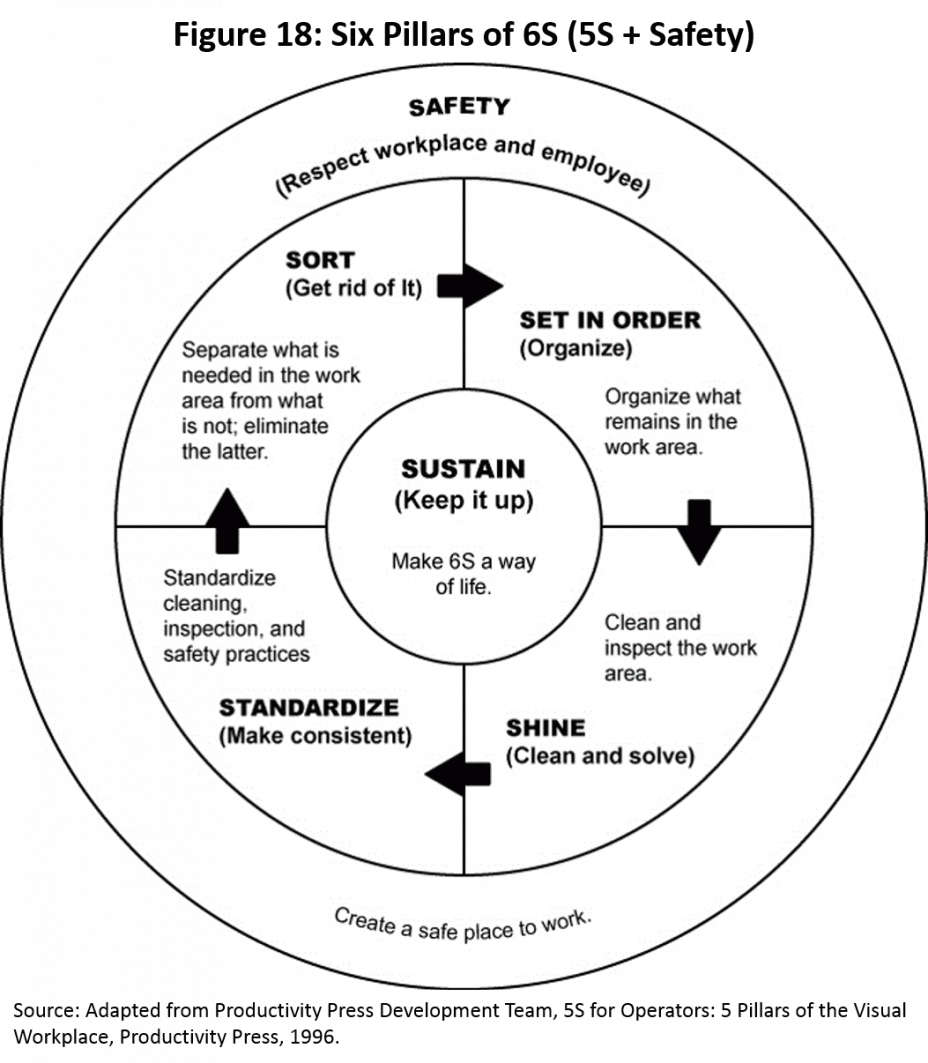 One key step that is relevant to reducing water use is “Shine,” since water is often used in cleaning and rinsing. Many industrial and manufacturing businesses use large amounts of water to flush lines, rinse parts and tanks, and clean equipment, floors, and other areas. These cleaning and rinsing practices often are large sources of wasteful water use and, therefore, opportunities for water savings. Educate employees on how to do the “Shine” step using less water, considering some of the Water-Efficient Cleaning Strategies in Box 17 below.
One key step that is relevant to reducing water use is “Shine,” since water is often used in cleaning and rinsing. Many industrial and manufacturing businesses use large amounts of water to flush lines, rinse parts and tanks, and clean equipment, floors, and other areas. These cleaning and rinsing practices often are large sources of wasteful water use and, therefore, opportunities for water savings. Educate employees on how to do the “Shine” step using less water, considering some of the Water-Efficient Cleaning Strategies in Box 17 below.
Since employees work attentively to maintain a clean and neat work environment in 5S, it presents a good opportunity to spot water waste. In daily 5S shop floor sweeps, encourage employees to check for water leaks in pipes, hoses, plumbing fixtures, and equipment, as well as turn off water that shouldn’t be running. Add checking for leaks to 5S checklists and other approaches implemented under “Standardize” and “Sustain” steps, so it becomes standard practice.
Water considerations are also relevant to “Safety.” Preventing water from being on the shop floor and walkways can eliminate slipping hazards. Repairing hot water and steam leaks can prevent burns.
Total Productive Maintenance
![]() As a key strategy for finding and preventing water losses, as well as other equipment failures, Total Productive Maintenance (TPM) is also relevant to water efficiency. TPM is a Lean method that focuses on optimizing the effectiveness of manufacturing equipment. TPM focuses on team-based maintenance that involves employees at every level and function.
As a key strategy for finding and preventing water losses, as well as other equipment failures, Total Productive Maintenance (TPM) is also relevant to water efficiency. TPM is a Lean method that focuses on optimizing the effectiveness of manufacturing equipment. TPM focuses on team-based maintenance that involves employees at every level and function.
A key practice in TPM is to maintain equipment in a manner that enables workers to quickly identify and correct problems that may result in leaks or spills. Since many facility operations use water, not just production processes, it’s important to extend the preventative maintenance ![]() practices of TPM to non-production areas (e.g., restrooms and irrigation) when looking for water issues. Box 18 outlines Proactive Maintenance Tips to Reduce Water Use that can be incorporated into a TPM program. For more tips and suggestions, see EPA’s “WaterSense at Work: Best Management Practices for Commercial and Institutional Facilities.”
practices of TPM to non-production areas (e.g., restrooms and irrigation) when looking for water issues. Box 18 outlines Proactive Maintenance Tips to Reduce Water Use that can be incorporated into a TPM program. For more tips and suggestions, see EPA’s “WaterSense at Work: Best Management Practices for Commercial and Institutional Facilities.”
Lean and Water Applications for Facility Operations and Support Processes
As noted earlier, the most water-consuming aspects of your facility may not be production processes; other facility water uses include cooling towers (which are often the largest water end use), boilers, support processes, restrooms, kitchens, and irrigation. Water balances, value ![]() stream maps, and other strategies in Chapter 3 describe how to identify the largest sources of water waste at your facility. These represent good targets for kaizen events to reduce water use. Consider the Questions to Identify Water-Savings Opportunities in Facility Operations and Support Processes in Box 19 to identify initial opportunities.
stream maps, and other strategies in Chapter 3 describe how to identify the largest sources of water waste at your facility. These represent good targets for kaizen events to reduce water use. Consider the Questions to Identify Water-Savings Opportunities in Facility Operations and Support Processes in Box 19 to identify initial opportunities.
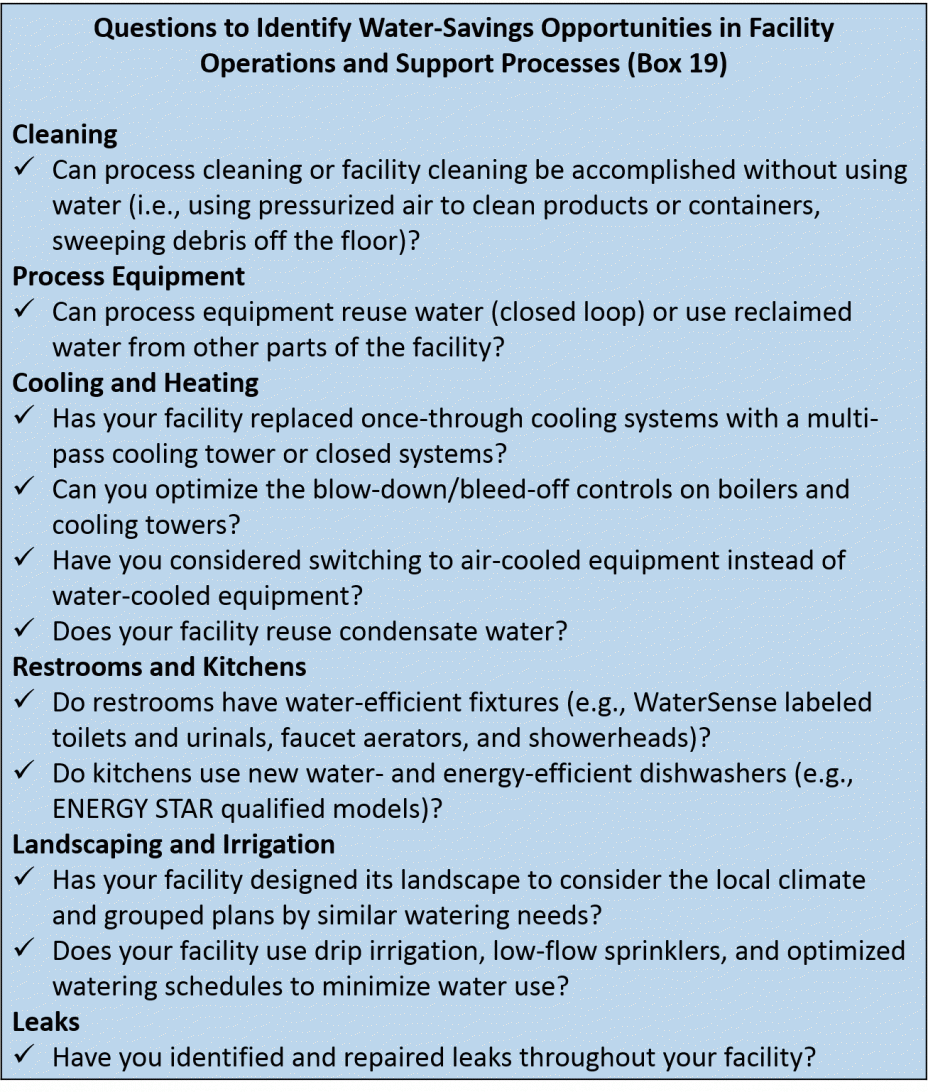
![]() Appendix D, Water Efficiency Opportunity Checklist, is a more extensive checklist for identifying water-savings opportunities throughout your facility.
Appendix D, Water Efficiency Opportunity Checklist, is a more extensive checklist for identifying water-savings opportunities throughout your facility.
Along with the questions in Box 19 and Appendix D, a wide array of resources are available that provide information on low-cost, water-efficiency measures for common components of facility operations, as well as resources that provide guidance and examples relevant to specific industries. Consider these water-efficiency strategies in your Lean improvement projects.
Toolkit Navigation
- Contents & Acknowledgements
- Executive Summary
- Preface
- Chapter 1: Introduction
- Chapter 2: Water Use and Water Waste at Industrial Facilities
- Chapter 3: Finding Water Waste on the Factory Floor
- Chapter 4: Lean and Water Efficiency Improvement Strategies
- Chapter 5: Lean and Water Beyond the Factory Floor
- Chapter 6: Conclusion
- Appendix A: Water Efficiency Resources and Technical Assistance Providers
- Appendix B: Water Cost Calculator
- Appendix C: Water Unit Conversions and Calculations
- Appendix D: Water Efficiency Opportunity Checklist
- Appendix E: Glossary of Water Terms


